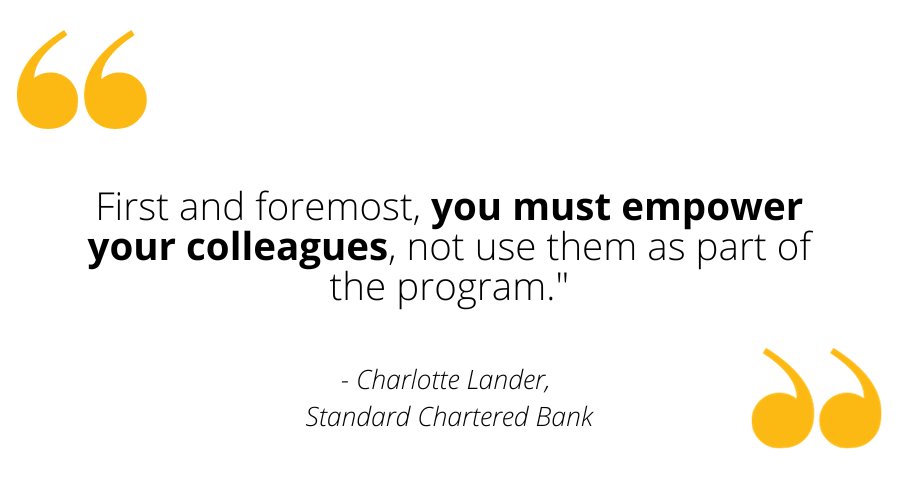In this podcast, Roger Christie speaks to Director of Social Media at Standard Chartered Bank Charlotte Lander to learn from her experience building a successful online employee advocacy program. Charlotte shares her expertise in both marketing and communications and her passion for employee advocacy. She explains the importance of a genuine approach and the need to move away from pre-approved corporate content.
Whether you’re an advisor or leader, this episode is a must listen. There’s a wealth of wisdom here as you tune into this best practice example and the practical advice Charlotte has to share for both you, your colleagues and your organisation. Let’s dive in.

What is an employee advocacy program & how to set your team up for success?
Employee advocacy refers to the practice of employees promoting and advocating for their organisation on social media and other online platforms. This form of advocacy has gained significant attention in recent years as organisations recognise the potential benefits it can bring.
To build genuine employee advocacy, Charlotte Lander reinforces the importance of organisations needing to adopt a different mindset. It is crucial to recognise that employees are the biggest strength of any organisation and that they can be passionate advocates for the brand. In this episode, Charlotte shares with Roger how the Standard Chartered Bank employee advocacy program started, beginning around eight years ago, with the aim of harnessing the positive conversations that employees were already having about the bank online.
The program’s goal was to provide support, measurement, and a framework for employees to amplify their advocacy efforts. Over the years, Charlotte explains how the program has evolved. Today, over half of Standard Chartered Bank’s management team now active on LinkedIn with the CEO being recognised as a top voice by the platform. This level of senior leader involvement sets a strong example for other employees and encourages them to engage in genuine advocacy for the Standard Chartered Bank brand.
Charlotte reinforces a key aspect of building genuine employee advocacy is the need to provide employees with the freedom to share their own thoughts and perspectives. She believes force-feeding branded content to employees and incentivising them to share it can come across as inauthentic. Instead, organisations should focus on empowering employees to share their unique experiences, insights, and expertise. This not only enhances the authenticity of the advocacy but also allows employees to showcase their personal brand and professional growth.
Another crucial element of building a successful, genuine employee advocacy is providing support and resources to employees. This includes training on social media best practices, guidelines for responsible sharing, and access to relevant content and resources. By equipping employees with the necessary tools and knowledge, organisations can ensure that their advocacy efforts align with the organisation’s goals and values.
In addition, Charlotte believes organisations need to leverage the power of their senior leaders; “You’ve got to have more than one leader active because otherwise that is a considerable risk and one that I’m sure no organisation wants to face today.” When senior leaders actively participate in online advocacy, it sets a powerful example for other employees and demonstrates their commitment to the brand. Standard Chartered Bank has seen significant success in this area, with its CEO and other executives being recognised for their effective use of LinkedIn.
5 commercial benefits of employee advocacy
As Roger and Charlotte discuss, there are several tangible commercial benefits that employee advocacy can generate.
Firstly, a key benefit is the ability to attract talent at a lower cost. When employees share positive experiences and insights about their organisation, they become brand ambassadors and can help attract potential candidates. This can be particularly effective when organisations have a connected and visible leadership team, as it creates a sense of trust and credibility for potential employees.
Secondly, employee advocacy can lead to more engaged employees. When employees have a personal connection to their organisation and are actively involved in promoting it, they become more invested in its success. This engagement can result in higher levels of productivity and employee satisfaction.

Thirdly, from a business perspective, employee advocacy can have a significant impact on the organisation’s pipeline. As shared in this conversation, research shows that 77% of people make purchasing decisions based on recommendations from people they trust. When employees advocate for their organisation, they can influence potential customers and generate more leads. In fact, employee networks can generate seven times more leads compared to other marketing strategies.
Furthermore, customers acquired through employee advocacy programs tend to have a higher lifetime value. This means that they are more likely to remain loyal to the organisation and continue to make purchases over an extended period. This can lead to increased revenue and profitability for the organisation.
Charlotte and Roge also emphasises the importance of aligning employee advocacy efforts with business goals and objectives. While it can be challenging to directly attribute the impact of advocacy programs to the bottom line, Charlotte believes organisations should strive to measure and demonstrate the value they bring. This can help secure buy-in from executives and ensure long-term support for the program.
For organisations starting their employee advocacy journey, Charlotte recommends starting small and focusing on demonstrating value. A pilot program can be an effective way to test the impact of advocacy efforts without committing significant resources. It is also important to have a clear vision and roadmap for the program, setting realistic goals and ambitions.
In summary, employee advocacy programs offer significant benefits – and once you’ve listened to Charlotte’s experience and insights, we have no doubt you’ll agree! By leveraging the power of connection and trust, organisations can humanise their brand and engage with their target audience on a deeper level.
Feel free to drop Roger Christie a note with any thoughts from this conversation. If you want more on all things digital reputation, be sure to subscribe below to the Your Digital Reputation newsletter. Join hundreds of subscribers from around the world already signed up!

